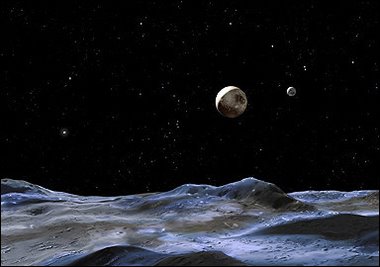 Pluto, center, with its moon Charon (below Pluto and right of center) and two newly discovered moons. From NASA.
Pluto, center, with its moon Charon (below Pluto and right of center) and two newly discovered moons. From NASA.This is an interesting story from CNN.Com:
(SPACE.com) -- The two moons discovered around Pluto last year were likely formed from the same giant impact that created the planet's much larger satellite, Charon, scientists say.
The idea suggests that other Kuiper Belt Objects might also harbor multiple satellites and raises the possibility that Pluto is encircled by rings fashioned from debris ejected from the surface of the tiny moons.
The two moons, called P1 and P2 for now, were discovered in May 2005 using the Hubble Space Telescope. Scientists now think the two moons are roughly 37 and 31 miles (60 and 50 kilometers) in diameter. Charon has an estimated diameter of about 750 miles (1,200 kilometers).
The moons' tiny sizes raise the possibility that even more satellites might be discovered around Pluto in the future.
"The very small masses of P1 and P2 relative to Charon beg the question of why ... there are not more small satellites of Pluto," a team of researchers write in the February 23 issue of the journal Nature. "Perhaps there are other, still fainter satellites that escaped detection."
Because of how P1 and P2 move, scientists think they were formed from the same collision that, according to the leading theory, spawned Charon.
"The small moons are in circular orbits in the same orbital plane as Charon, and they are also in, or very near, orbital resonance with Charon," said study leader Alan Stern of the Southwest Research Institute (SwRI).
For every twelve orbits Charon makes around Pluto, P1 makes almost two orbits and P2 completes nearly three. This ratio would likely not be constant if P1 and P2 were merely passing objects captured by Pluto's gravity. The most likely explanation for this arrangement, scientists figure, is that all three moons were born of the same event.
Collisions between large objects helped shape many aspects of our solar system. The Moon, for example, is believed to have formed when a Mars-sized object slammed into Earth 4 billion years ago. The crash that's thought to have created Pluto's moons is believed to have occurred at around the same time.This illustration released by NASA shows the Pluto system from the surface of one of the candidate moons. Pluto is the large disk at center right and its confirmed moon Charon is the smaller disk to the right of Pluto. Astronomers using the Hubble telescope have determined that Pluto has two tiny satellites in addition to Charon.(AFP/NASA-HO/File)
Scientists will get a closer look at Pluto and its moons when NASA's recently launched New Horizon mission reaches the system in 2015. (Full story)
Scientists have determined that up to a fifth or more of known Kuiper-belt objects (KBOs)harbor satellites or belong to binary systems; the new modeling suggests that there could also be numerous systems consisting of three, four or even more bodies grouped together.
But finding these systems is difficult because of the distances involved. The Kuiper belt is a region of space populated by asteroids and comets and other rocky, icy bodies; it is located beyond Neptune, between 30 and 50 AU from Earth. One AU is equal to the distance from the Earth to the sun.
"Finding small satellites around KBOs is difficult because their large distances from the Sun makes them appear very faint," said study team member Andrew Steffl of SwRI.
However, KBOs and their satellites are occasionally ejected from the Kuiper Belt and get flung closer to the Sun, where they become easier to spot. Steffl said a good way to determine whether KBOs with multiple satellites are unusual or the norm is to search for satellites around these outcasts, which are known as "Centaurs."
"We hope to use Hubble to search for faint moons around some of them," Steffl said.
The discovery of P1 and P2 also raises the intriguing possibility that impact debris from the small moons is captured by Pluto's gravity and coalescing into rings or even arcs around the tiny planet. If confirmed, it would be the first example of a ring system around a solid body rather than a gas giant planet.

No comments:
Post a Comment